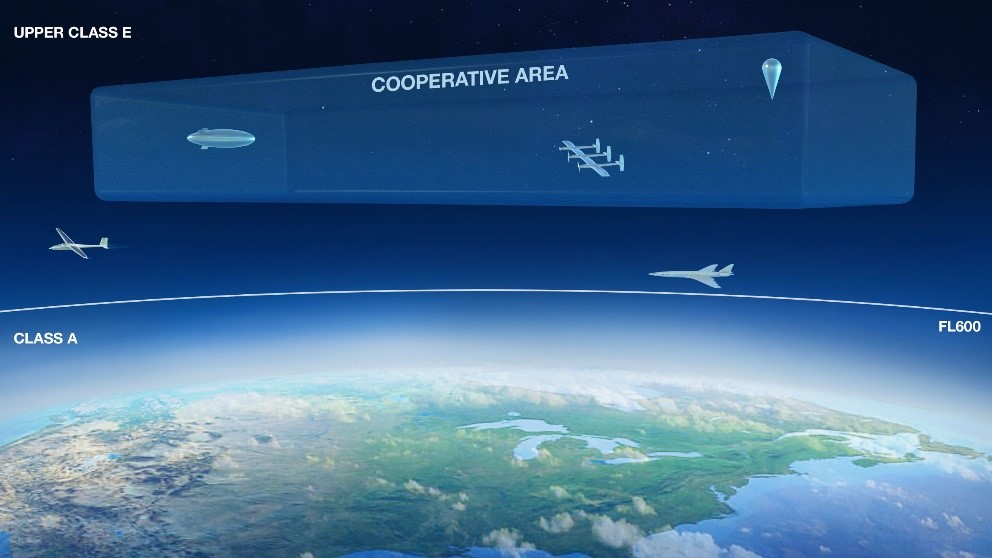Upper Class E Traffic Management (ETM)
Defining Upper Class E Operations
Upper Class E airspace operations refer to those that take place over 60,000 feet above mean sea level (MSL) in the National Airspace System (NAS). Operations in upper Class E airspace have historically been limited due to the challenges faced by conventional fixed wing aircraft in reduced atmospheric density. However, recent advances in power and propulsion technology, aircraft structures, flight automation, and aerodynamics have increased the number of vehicles that can now operate in the low atmospheric density airspace that is characteristic of upper Class E. This means that sophisticated high altitude, long endurance (HALE) vehicles, unmanned free balloons, airships, and supersonic/hypersonic aircraft can now efficiently and economically satisfy research objectives, demands for broad coverage services (i.e., earth sensing, telecommunications), and supersonic passenger flight.

Figure 1: National Airspace System, depicting Upper Class E traffic management (ETM) operations
The Need for ETM
In the United States, there are no specific provisions for aircraft operations above 60,000 feet for civil aircraft, and most existing applications are limited to military operations. Existing Air Traffic Management (ATM) systems are unable to cost-effectively accommodate upper Class E airspace needs, and they are not necessarily feasible or desirable for upper Class E operations.
The predicted increase in operations, disparate vehicle performance characteristics, and unconventional operational needs present novel challenges for the current airspace infrastructure and require fresh solutions. Leveraging other related approaches, such as UAS Traffic Management (UTM) (PDF), the FAA and NASA are collaborating with industry stakeholders to develop an upper Class E traffic management (ETM) concept intended to support future operations and scale for application.
ETM Vision
 New technologies have enabled the design and development of vehicles that can operate at very high altitudes. As demand grows with the advent of emerging technology and business markets, the future of upper Class E airspace operations presents opportunities for an alternative traffic management approach that ensures safe and efficient service provision.
New technologies have enabled the design and development of vehicles that can operate at very high altitudes. As demand grows with the advent of emerging technology and business markets, the future of upper Class E airspace operations presents opportunities for an alternative traffic management approach that ensures safe and efficient service provision.
An ETM construct will:
- Scale beyond the current NAS infrastructure and workforce resources to meet the needs of market forces
- Support the management of operations where no air navigation service provider (ANSP) separation services are desired, appropriate, and/or available
- Promote shared situation awareness among operators
Additionally, it is important to develop an ETM regulatory framework, operating rules, performance-based standards and procedures, and roles and responsibilities that ensure the accountability of operators. As the federal authority over operations in all airspace and the regulating authority over operations, the FAA will ensure that the ETM cooperative vision aligns with agency goals and meets the requirements for safe and efficient operations.

Figure 2: ETM airspace management model
The ETM Concept of Operations
The ETM Concept Operations (PDF) (ConOps), documents the FAA’s work with NASA and industry stakeholders and presents the vision for ETM. It describes how operators (1) plan their flights to upper Class E airspace, (2) interact with the ATM system and Air Traffic Control (ATC) during transit phases of flight, and (3) manage contingency events. The ConOps also defines the roles and responsibilities of the operator and ATC/ATM and presents high-level use cases that demonstrate the conduct of these operations. Although it does present foundational operating principles for ETM above 60,000 feet, subsequent versions of the ConOps will more comprehensively address a cooperative traffic management approach for this airspace.
The ETM ConOps V1.0 was released in May 2020 and will help to inform the policies, regulations, services, and infrastructure required to support safe and equitable operations in the NAS.
ETM Communication, Navigation, and Surveillance (CNS) White Papers
The FAA has published a series of white papers that identify and analyze emerging and/or existing Communication, Navigation, and Surveillance (CNS) capabilities applicable to the ETM environment. The documents assess various CNS technologies and examine some of the advantages, disadvantages, current level of support, and potential modifications for increased ETM operations support. The white papers are intended to provide options that may support Operators in ETM airspace, rather than prescribe any one solution. The papers are linked below under "Reference Documents."
Contact
For additional information regarding ETM, please send an email to 9-ANG-ETM@faa.gov.
Reference Documents
- ETM Concept of Operations v1.0 (PDF)
- ETM Communication, Navigation, and Surveillance (CNS) Summary Report (PDF)
- Existing Communication Technologies for ETM (PDF)
- Existing Navigation Technologies for ETM (PDF)
- Existing Surveillance Technologies for ETM (PDF)
